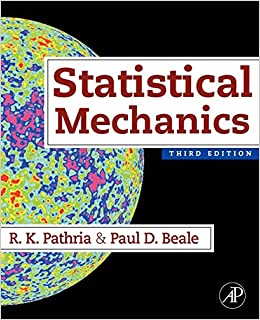To determine the equilibrium distribution (f(sigma)), we minimize the free en(operatorname{ergy}(E-T S)) of the system under the
Question:
To determine the equilibrium distribution \(f(\sigma)\), we minimize the free en\(\operatorname{ergy}(E-T S)\) of the system under the obvious constraint \(\sum_{\sigma} f(\sigma)=1\). For this, we vary the function \(f(\sigma)\) to \(f(\sigma)+\delta f(\sigma)\) and require that the resulting variation
\[
\begin{aligned}
\delta(E-T S) & =\frac{1}{2} q N \sum_{\sigma^{\prime}, \sigma^{\prime \prime}} u\left(\sigma^{\prime}, \sigma^{\prime \prime}\right)\left\{f\left(\sigma^{\prime}\right) \delta f\left(\sigma^{\prime \prime}\right)+f\left(\sigma^{\prime \prime}\right) \delta f\left(\sigma^{\prime}\right)\right\} \\
& +N k T \sum_{\sigma^{\prime}}\left\{1+\ln f\left(\sigma^{\prime}\right)\right\} \delta f\left(\sigma^{\prime}\right)=0,
\end{aligned}
\]
while \(\sum_{\sigma^{\prime}} \delta f\left(\sigma^{\prime}\right)\) is, of necessity, zero. Introducing the Lagrange multiplier \(\lambda\) and remembering that the function \(u\left(\sigma^{\prime}, \sigma^{\prime \prime}\right)\) is symmetric in \(\sigma^{\prime}\) and \(\sigma^{\prime \prime}\), our requirement takes the form
\[
\sum_{\sigma^{\prime}}\left\{q N \sum_{\sigma^{\prime \prime}} u\left(\sigma^{\prime}, \sigma^{\prime \prime}\right) f\left(\sigma^{\prime \prime}\right)+N k T\left\{1+\ln f\left(\sigma^{\prime}\right)\right\}-\lambda\right\} \delta f\left(\sigma^{\prime}\right)=0 .
\]
Since the variation \(\delta f\left(\sigma^{\prime}\right)\) in this expression is arbitrary, the condition for equilibrium becomes
\[
q N \sum_{\sigma^{\prime \prime}} u\left(\sigma^{\prime}, \sigma^{\prime \prime}\right) f\left(\sigma^{\prime \prime}\right)+N k T \ln f\left(\sigma^{\prime}\right)-N \mu=0
\]
where \(\mu=(\lambda-N k T) / N\). By a change of notation, we get the desired result
\[
\begin{equation*}
f(\sigma)=C \exp \left[-\beta q \sum_{\sigma^{\prime}} u\left(\sigma, \sigma^{\prime}\right) f\left(\sigma^{\prime}\right)\right] \tag{1}
\end{equation*}
\]
where \(C\) is a constant to be determined by the normalization condition \(\sum_{\sigma} f(\sigma)=1\).
For the special case \(u\left(\sigma, \sigma^{\prime}\right)=-J \sigma \sigma^{\prime}\), where the \(\sigma^{\prime}\) 's can be either +1 or -1 , eqn. (1) becomes
\[
\begin{equation*}
f(\sigma)=C \exp [\beta q J \sigma\{f(1)-f(-1)\}] \tag{2}
\end{equation*}
\]
Writing \(f(\sigma)=\frac{1}{2}\left(1+\bar{L}_{0} \sigma\right)\), the quantity \(f(1)-f(-1)\) becomes precisely equal to \(\bar{L}_{0}\), and eqn. (2) takes the form
\[
\begin{equation*}
f(\sigma)=C \exp \left[\beta q J \sigma \bar{L}_{0}\right] \tag{3}
\end{equation*}
\]
From equation (3), we obtain
\[
\begin{align*}
& f(1)+f(-1)=2 C \cosh \left(\beta q J \bar{L}_{0}\right)=1, \text { while } \tag{4}\\
& f(1)-f(-1)=2 C \sinh \left(\beta q J \bar{L}_{0}\right)=\bar{L}_{0} \tag{5}
\end{align*}
\]
Dividing (5) by (4), we obtain the Weiss eqn. (12.5.11) for \(\bar{L}_{0}\).
Step by Step Answer:






